Identification of the scaramanga gene implicates Neuregulin3 in mammary gland specification
- PMID: 16140987
- PMCID: PMC1199577
- DOI: 10.1101/gad.338505
Identification of the scaramanga gene implicates Neuregulin3 in mammary gland specification
Abstract
The mouse scaramanga (ska) mutation impairs mammary gland development such that both abrogation and stimulation of gland formation occurs. We used positional cloning to narrow the interval containing scaramanga (ska) to a 75.6-kb interval containing the distal part of the Neuregulin3 (Nrg3) gene. Within this region the only sequence difference between ska and wild-type mice is in a microsatellite repeat within intron 7. This alteration correlates with variations in Nrg3 expression profiles both at the whole embryo level and locally in the presumptive mammary region in ska mice. Localized expression of Nrg3 and its receptor, Erbb4, in the presumptive mammary region around the future bud site prior to morphological appearance of buds and the expression of bud epithelial markers further support an inductive role. Finally, Neuregulin3 (Nrg3)-soaked beads can induce expression of the early bud marker Lef1 in mouse embryo explant cultures, and epithelial bud formation can be observed histologically, suggesting that initiation of mammary bud development occurs. Taken together, these results indicate that a Neuregulin signaling pathway is involved in specification of mammary gland morphogenesis and support the long-held view that mesenchymal signal(s) are responsible for mammary gland inductive/initiating events.
Figures
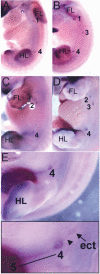


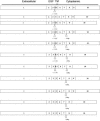
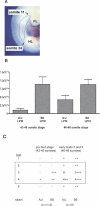

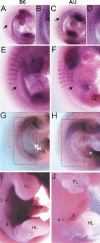
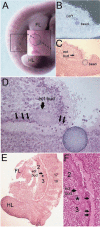


Similar articles
-
The role of NRG3 in mammary development.J Mammary Gland Biol Neoplasia. 2008 Jun;13(2):195-203. doi: 10.1007/s10911-008-9082-8. Epub 2008 Apr 17. J Mammary Gland Biol Neoplasia. 2008. PMID: 18418701 Review.
-
Neuregulin-3 regulates epithelial progenitor cell positioning and specifies mammary phenotype.Stem Cells Dev. 2014 Nov 15;23(22):2758-70. doi: 10.1089/scd.2014.0082. Epub 2014 Aug 11. Stem Cells Dev. 2014. PMID: 24936779
-
Dynamic expression of Erbb pathway members during early mammary gland morphogenesis.J Invest Dermatol. 2008 Apr;128(4):1009-21. doi: 10.1038/sj.jid.5701118. Epub 2007 Oct 25. J Invest Dermatol. 2008. PMID: 17960183
-
Neuregulin3 alters cell fate in the epidermis and mammary gland.BMC Dev Biol. 2007 Sep 19;7:105. doi: 10.1186/1471-213X-7-105. BMC Dev Biol. 2007. PMID: 17880691 Free PMC article.
-
Neuregulin 3 and erbb signalling networks in embryonic mammary gland development.J Mammary Gland Biol Neoplasia. 2013 Jun;18(2):149-54. doi: 10.1007/s10911-013-9286-4. Epub 2013 May 7. J Mammary Gland Biol Neoplasia. 2013. PMID: 23649700 Review.
Cited by
-
Ectodysplasin/NF-κB signaling in embryonic mammary gland development.J Mammary Gland Biol Neoplasia. 2013 Jun;18(2):165-9. doi: 10.1007/s10911-013-9277-5. Epub 2013 Apr 17. J Mammary Gland Biol Neoplasia. 2013. PMID: 23591968 Review.
-
Transcriptome analysis of embryonic mammary cells reveals insights into mammary lineage establishment.Breast Cancer Res. 2011 Aug 11;13(4):R79. doi: 10.1186/bcr2928. Breast Cancer Res. 2011. PMID: 21834968 Free PMC article.
-
Diverse functional networks of Tbx3 in development and disease.Wiley Interdiscip Rev Syst Biol Med. 2012 May-Jun;4(3):273-83. doi: 10.1002/wsbm.1162. Epub 2012 Feb 14. Wiley Interdiscip Rev Syst Biol Med. 2012. PMID: 22334480 Free PMC article.
-
The neuregulin family of genes and their multiple splice variants in breast cancer.J Mammary Gland Biol Neoplasia. 2008 Jun;13(2):205-14. doi: 10.1007/s10911-008-9078-4. Epub 2008 Apr 15. J Mammary Gland Biol Neoplasia. 2008. PMID: 18415007 Review.
-
ERBB3/HER3 and ERBB2/HER2 duet in mammary development and breast cancer.J Mammary Gland Biol Neoplasia. 2008 Jun;13(2):215-23. doi: 10.1007/s10911-008-9083-7. Epub 2008 May 3. J Mammary Gland Biol Neoplasia. 2008. PMID: 18454306 Free PMC article. Review.
References
-
- Andl T., Reddy, S.T., Gaddapara, T., and Millar, S.E. 2002. WNT signals are required for the initiation of hair follicle development. Dev. Cell 2: 643-653. - PubMed
-
- Anton E.S., Ghashghaei, H.T., Weber, J.L., McCann, C., Fischer, T.M., Cheung, I.D., Gassmann, M., Messing, A., Klein, R., Schwab, M.H., et al. 2004. Receptor tyrosine kinase ErbB4 modulates neuroblast migration and placement in the adult forebrain. Nat. Neurosci. 7: 1319-1328. - PubMed
-
- Balinsky B. 1949-1950. On the developmental processes in mammary glands and other epidermal structures. Transactions of the Royal Society Edinburgh 62: 1-31.
-
- Bamshad M., Lin, R.C., Law, D.J., Watkins, W.C., Krakowiak, P.A., Moore, M.E., Franceschini, P., Lala, R., Holmes, L.B., Gebuhr, T.C., et al. 1997. Mutations in human TBX3 alter limb, apocrine and genital development in ulnar-mammary syndrome. Nat. Genet. 16: 311-315. - PubMed
-
- Bell A.G. 1898. On the development by selection of supernumerary mammae in sheep. Science 9: 6337-6339. - PubMed
Publication types
MeSH terms
Substances
Grants and funding
LinkOut - more resources
Full Text Sources
Molecular Biology Databases
